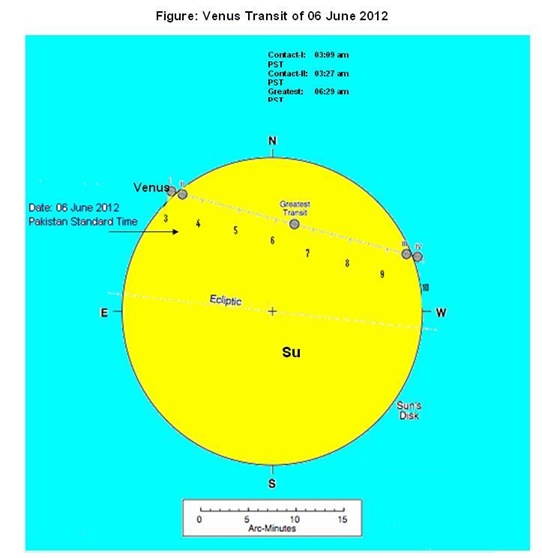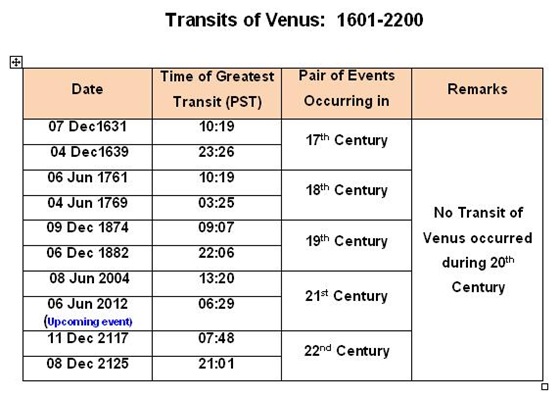Transit of planet Venus occurring on 06 June 2012
Current Event:
On June 6th 2012, a transit of Venus across the disk of the Sun will take place. The event will be visible from Pakistan. When the Sun will rise on 6th June, it will be already in Transit Phase and the planet Venus will be at the stage of Greatest Transit, almost later half part of the event will be visible from Pakistan, please see figure below. The event will also be visible from the Pacific Ocean and many countries of Europe, eastern Africa, western and central Asia, western Australia, North America and northern South America. Total duration of the Transit will be 6 hours and 40 minutes.
Past and Future Events:
Since the invention of the telescope (AD 1610), there have only been seven transits as listed (Early seven entries) in the following Table. After the current event the next pair of event will be visible on 11 Dec 2117 and 08 Dec 2125. It is very rare event. There was no Transit of Venus occurred during 20th Century
.
Observation & Care:
The Venus transits are very rare which occur when the Venus passes in front of the Sun as seen from the Earth. The transit of Venus occurs in pairs with more than a century separating each pair. The last Venus transit was in 2004 so the second event of the pair will occur on Wednesday, June 6, this year in Pakistan. Since the apparent diameter of Venus is nearly 1 arc-minute, and apparent diameter of the Sun is 32 arc-minute, hence the planet Venus appears to be only 1/32 of the Sun's apparent diameter. However it is just possible to see the Venus without optical magnification like a tiny black dot over the Sun disk as it crosses the Sun (but using solar filter protection). However a pair of binoculars or a small telescope at modest power will offer a much more satisfying view.
All binoculars and telescopes must be suitably equipped with adequate filtration to ensure safe solar viewing. The visual and photographic requirement for observing a transit is identical to those for solar viewing. Observation, without proper eye protection i.e. without using suitable and reliable filters may lead to permanent blindness. So proper eye care measure must be taken in this regard.
The Principal Events:
The principal events occurring during a transit are conveniently characterized by contacts, analogous to the contacts of an annular solar eclipse. The Transit includes on Contact-I to Contact-IV explained as follows:
Contact-I: The transit begins with contact-I, the instant the planet's disk externally just touch the Sun at 03:09 am according to PST
(Please see the figure given below).
Contact-II: Shortly after contact-I, the planet can be seen as a small notch along the solar limb. The entire disk of the planet is first seen at contact-II at 03:27 am (PST), when the planet is internally tangent to the Sun. Over the course of several hours, the silhouetted planet slowly traverses the solar disk.
Greatest: The instant when the Venus will be at center point of its journey over solar disk at 06:29 am PST.
Contact-III: At Contact-III, the planet reaches the opposite limb and once again is internally tangent to the Sun at 09:31 am
Contact-IV: Finally, the transit ends at Contact IV when the planet's limb is externally tangent to the Sun 09:49 am PST.
Contacts-I and II define the phase called Ingress while contacts-III and IV are known as Egress. It may be noted that Contact-I and Contact-IV cannot be observed without special optical equipment.

Shahzad Afzal
http://www.pakistanprobe.com/













No comments:
Post a Comment